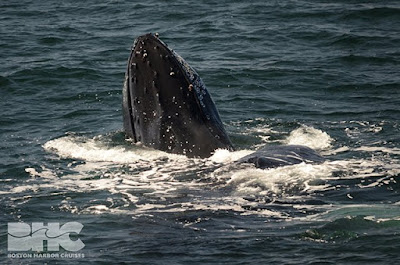Today I joined with team Sanctuary and Captain Earl for an excursion north of the shipping lanes, and for both of today’s whale watches we found a formidable cetacean spectacle just over the western ridge of Stellwagen Bank.
 |
| Gumdrop shows off |
Dubbed appropriately “Earl’s Mother Load”, this site brimmed with emerald green cauldrons of bubble nets emitted by feeding behemoths. An airship black and mighty punctuated the cloudless blue void; we found ourselves with a humpback whale named Gumdrop who thought itself more avian than leviathan (photo)! This flighty beast carried on with several more breaches before double-flipper slapping, nearly robbing its humpback companion of our awe (photo).
 |
| Double flipper slapping |
This association of pelagic giants eventually showcased their submarine prowess, fluking for dives of 1-2 minutes and surfacing for single breaths before being joined by a third unidentified humpback. A second association of two anonymous humpbacks passed our bow, but our attention was duly captured by a solitary kickfeeder named Sundown! This aquatic theatre was situated within the outskirts of the Speed Reduction Zone, and I found agreement with our captain that a necessary reduction in boat speed would be worth a second visit.
 |
| See the humpback's baleen peeking out of its lips |
 |
| Chin breach |
For the 2pm excursion we investigated just a few feeding associations amidst a vast baleen bazaar of 12+ whales. From the mysticete marvel of kickfeeding humpbacks we identified the fluke patterns of Gladiator, Whirlygig, and Shuffleboard!
 |
Our olfactory senses were nearly overloaded as two feeding groups filtered the water for hapless fish; our eyes and noses were defenseless against winds pungent with snarge. Our ears pricked to the trumpeting blows of two large humpbacks, and our eyes were attentive to brown fecal clouds emitted from humpback bowels (photo).
 |
| Gumdrop's fluke |
 |
| Juvenile fluking |
Our last looks were of an unknown juvenile we knighted as “16BH19”. While its proportions were suggestive of youth, its curiosity and penchant for prancing along bow repeatedly certainly indicated a youthful exuberance. Mindful of whale watching guidelines, Earl allowed this humpback swim away from the Sanctuary to depart for deeper seas before we reluctantly headed west for Boston.
 |
We were honored to have the Calvineers join us on today’s afternoon excursion as these young scientific minds use education to advocate the protection of endangered species such as the North Atlantic Right Whale. Both the Calvineers and New England Aquarium Whale Watch were represented at the New England Right Whale Festival, hope you were able to join us!
— Rich
































